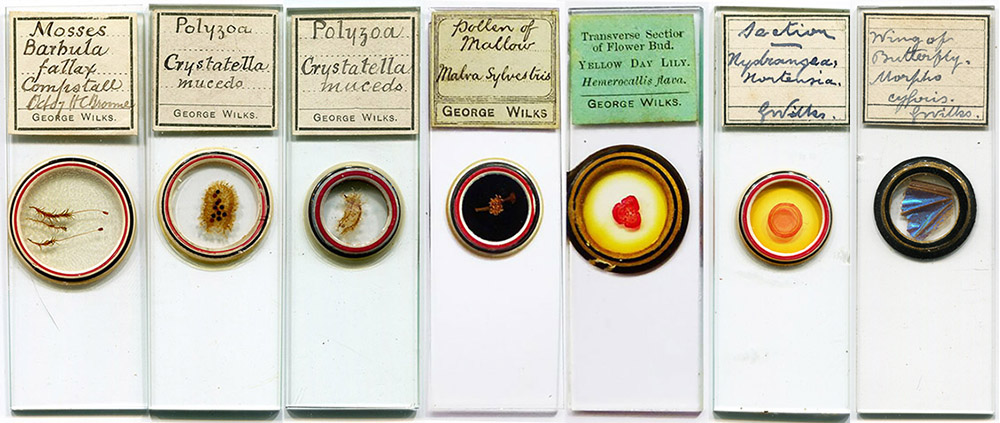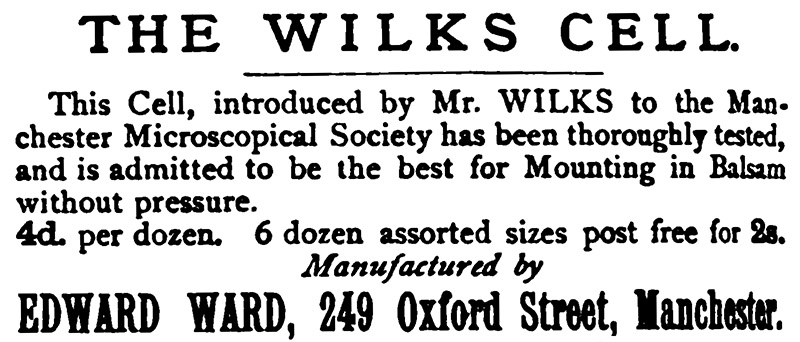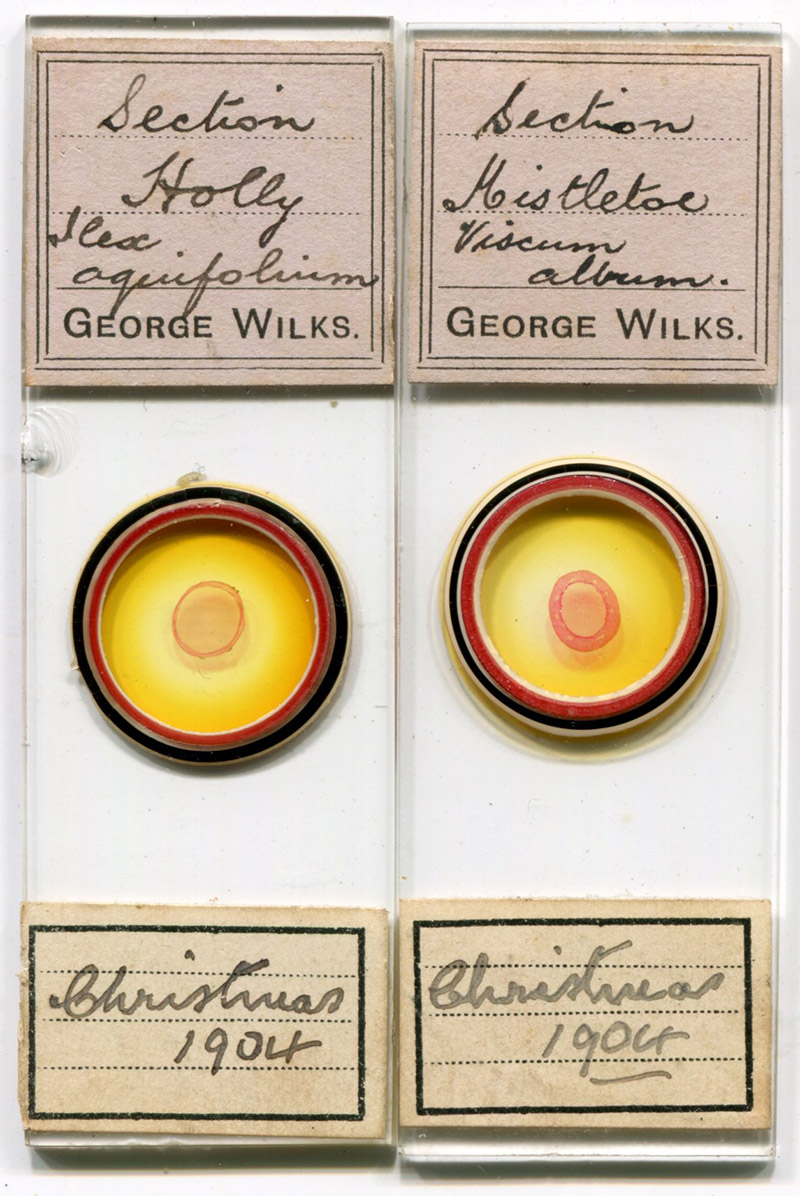George Wilks, 1836 - 1918
by Brian Stevenson
last updated July, 2018
George Wilks was a member of the Manchester Microscopical Society for nearly 40 years. For most of that time, he was active in the Society’s Mounting Section, a group dedicated to improving slide-making skills. The effect is apparent in many of Wilks’ slides, which are generally well-made and often finished with striking patterns of ringing (Figure 1).
Wilks became somewhat famous in his time due his invention of an inexpensive cell for preparing deep mounts (Figure 2). They were retailed nationwide by fellow MMS member Edward Ward (Figure 3).

Figure 1.
Examples of slides prepared by George Wilks. He is known to have been an active microscopist between 1882 and the time of his death, in 1918. From the author’s collection or adapted from internet auction sites for nonprofit, educational purposes.
George was born on September 3, 1836, in Manchester, England. His father, John, was described in records as being a “packer” (a relatively unskilled manual laborer).
Wilks learned accounting, and worked as a bookkeeper throughout his life.
He married Hannah Ogden on June 16, 1859, at Manchester Cathedral. They had two children, both daughters. At the times of the 1871 and 1881 censuses, Hannah worked as a dress maker, probably from the family home.
Wilks joined the Manchester Microscopical Society in 1882. He was Secretary by 1886, and served in several other offices during his many years with the Society. In 1889, Wilks was lauded as “an ardent microscopical student, and has done splendid work for the society …, especially in connection with the Mounting Section”.
He was a competent slide-maker by 1883. Late in that year, he posted an exchange offer in Hardwicke’s Science-Gossip, “Wanted, vol. 1. of ‘Northern Microscopist’ bound or in numbers. Will exchange in slides. - G. Wilks, 27 Wynford Street, Weaste, Manchester”.
The “Wilks Cell” was introduced to the MMS during a February, 1884 meeting of the Mounting Section. Chairman J.L.W. Miles used some of Wilks’ inventions to prepared deep mounts of bee heads, in the style of Frederick Enock. Miles stated, “two difficulties are usually met with in the putting up of this kind of mount - imprisonment of air bubbles and shrinkingage of the medium by evaporation - to obviate which, in the use of balsam, a new cell, having alternate elevations and depressions, has been devised by a member of the section”.
Descriptions and a published illustration (Figure 2) indicate that Wilks Cells were made of “soft metal”, probably lead. The substance was soft enough that one could reduce the depth of the cell by squeezing it between two glass slides. There were four equally-spaced crimps, creating ridges that held the cover slip while permitting air bubbles and excess balsam mountant to escape through the gaps between. After the mountant had set, the microscopist would seal the gaps and finish with ringing paint.
At this time, Wilks worked as bookkeeper for an engineering firm. It is possible that his work colleagues helped him design and manufacture the cells.
Wilks’ distributor, Edward Ward, exhibited the cells to his colleagues in London in the Royal Microscopical Society. He first showed them on March 12, 1884. A write-up in The Journal of the Royal Microscopical Society, “Wilks's Cell. - Mr. E. Ward supplies cells for mounting without pressure in Canada balsam made on a plan suggested by Mr. Wilks ... The cell is made of soft metal and, as will be seen from the figure, has four elevations alternating with depressions, the cover-glass resting on the upper points of the curves. By leaving an excess of balsam round the cell and cover-glass, air-bubbles ultimately escape through the spaces, and loss by evaporation of essential oil in the balsam is provided for. If the cell is too deep for the object it can be pressed between two glass slips until shallow enough”. This undoubtedly led to increased demand for the cells.
Edward B.L. Brayley (F.R.M.S.) wrote in 1885, “Mounting Insects - In reply to a query of F.R. Brokenshire:-The best cell I have seen, or used for mounting insects whole, without pressure, is a metal cell with four equidistant projections. It was lately figured and described in the Journal of the Royal Microscopical Society. The projections on the cell are to support the cover glass, and the spaces between the projections allow the balsam or other medium, in which the object is mounted to harden. The cell is admirably adapted for the purpose for which it is intended, and is certainly a most ingenious arrangement. Mr. George Wilks, of Weaste, near Manchester, is the inventor; and doubtless a note dropped to him would bring far more information about the invention, and how to use it, &c., than I can give the inquirer”.
In 1886, James Neville weighed in on a query from a microscopist who used the initials R.S.P., “Wilks' Cell. - It is somewhat difficult to give R.S.P. the information he seeks on the manner of using the Wilks' cell, without first knowing how advanced he may be in the preparation of objects without pressure. It requires a considerable amount of care to get the objects ready for the cell, but when this is done the mounting of them is the easiest part. If R.S.P. refers only to this latter part, he will find no difficulty if he proceeds as follows. Take a cell and see that it is no deeper than the object requires. If it is too deep it can easily be flattened between two pieces of glass by pressure, until the exact depth is gained. All that remains then to be done is to place it on a clean slip, fill it with thick balsam, and, immersing the prepared object, put on the cover glass. In using the thick balsam, numerous air bubbles will most likely appear in the cell. This is a small matter, for if kept in a warm place they will gradually work to the edge and disappear. If R.S.P. wishes for anything like full information on the preparation of objects for the cell, I fear it cannot be given without devoting at least one article to the subject. The Wilks' cell is a very useful introduction, and deserves to be largely used. Prior to its invention I have frequently extemporised one from a vulcanite cell, that sufficiently answered the purpose, although at the cost of time and trouble. Still I think the cell is open to improvement, and would suggest that it had at least twice the number of elevations, or, perhaps better still, was corrugated, as in its present form the cover glass is likely to get broken unless well banked up with edging colour, as there is so large a space between the supports. J.W. Neville, Handsworth, Birmingham”.
Wilks developed an “improved microtome” in 1888, and presented it to the MMS, “At the April meeting of the Mounting Section, Mr. Wilks exhibited and used an improved form of microtome designed by himself, the principle feature of which is that the cutting plate, or head, is removable, it is fitted to the lower part, by a socket joint, and secured either by a bayonet catch, or a screw. The hole in the plate or head is bored taper, and is 1/16 of an inch less in diameter at the outside. than in the well or tube of the microtome, thus effectually counteracting the effect of shrinkage in the embedding material. The diameter of the well is also much less than in the older form of microtome: an improvement, the value of which every microscopist must appreciate, it is fitted with the usual divided milled head and spring indicator for guaging the thickness of the sections”.
During the late 1890s, Wilks also joined the MMS Extension Section. This was described in Nature, 1900, “The members of the Manchester Microscopical Society deserve a word of encouragement for the efforts they make to extend a knowledge of natural history. One section of the society is entirely concerned with this work, and the members of it propagate the gospel of natural history by lecturing and demonstrating wherever their services are required. A programme containing a list of nearly fifty subjects has been issued, and the honorary secretary, Mr. George Wilks, 56, Brookland Street, Eccles New Road, Manchester, will arrange for lectures or demonstrations upon any of them if a communication is made to him”.
George’s wife, Hannah, died in 1901. Wilks remained in his home for a few more years, assisted by an unmarried granddaughter. In 1907, he moved in with his eldest daughter’s family in Stretford, Lancashire. The 1911 census recorded George Wilks as a “retired engineer’s clerk”.
George died in May, 1918, at the age of 81. His colleagues at the MMS wrote of, “the great part played by Mr. Wilks who filled with conspicuous success nearly every office in the Society”, and “Mr. Wilks was one of our most active members for about 30 years, having worked for the Section in every possible way. As an expert demonstrator in methods of mounting, he was very much appreciated. The reports of the Section bear witness of his work”.

Figure 2.
A diagram of a Wilks Cell, placed on a 1x3 inch slide. From “The Journal of the Royal Microscopical Society”, 1884.

Figure 3.
Advertisement by Edward Ward for Wilks’ Cells. From “Hardwicke’s Science-Gossip”, 1885.

Figure 4.
Two slides that George Wilks made from Christmas decorations in 1904. Bracegirdle’s “Microscopical Mounts and Mounters” shows a similar preparation of ivy from 1897.
Resources
Annual Report and Transactions of the Manchester Microscopical Society (1905) Members: “1882, Wilks, George, 56, Brookland Street, Weaste”
Annual Report and Transactions of the Manchester Microscopical Society (1906) Members: “1882, Wilks, George, 1073, Tenth Street, Trafford Park”
Annual Report and Transactions of the Manchester Microscopical Society (1907) Members: “1882, Wilks, George, 6, Harcourt Street, Gorse Hill, Stretford”
Annual Report and Transactions of the Manchester Microscopical Society (1916)
Bracegirdle, Brian (1998) Microscopical Mounts and Mounters, Quekett Microscopical Club, London, pages 103 and 178, Plate 37-K
Brayley, Edward B.L. (1885) Mounting insects, Hardwicke's Science-Gossip, Vol. 21, page 65
England census and other records, accessed through ancestry.com
Hardwicke's Science-Gossip (1883) Exchange offer from George Wilks, Vol. 19, page 284
Hardwicke's Science-Gossip (1885) Advertisement from Edward Ward for Wilks Cells, Vol. 21, page lxxviii
Herbology Manchester (published December 10, 2017, accessed March, 2018) https://herbologymanchester.wordpress.com/tag/microscope-slides
Journal of the Royal Microscopical Society (1884) Reports on Wills Cells, Series 2, Vol. 4, pages 333, 336, and 476
Microscopical News and Northern Microscopist (1884) Report on meeting of the Manchester Microscopical Society Mounting Section, Vol. 4, pages 55-56
Nature (1900) Note on the Manchester Microscopical Society Extension Section, Vol. 62, page 424
Neville, J.W. (1886) Wilks’ Cell, Hardwicke's Science-Gossip, Vol. 22, page 233
Research (1889) Report on the Annual Exhibition and Conversazione of the Manchester Microscopical Society, Vol. 1, page 117
Wilks, George (1888) An improved microtome, Annual Report of the Manchester Microscopical Society, pages 86-87
Wilks, George (1888) Mounting in Glycerine Jelly, Transactions and Annual Report of the Manchester Microscopical Society, page 13



